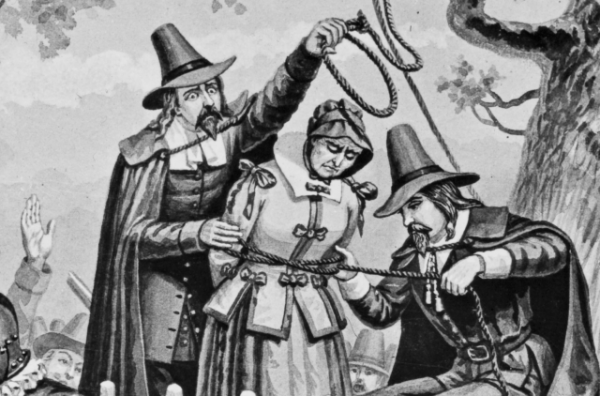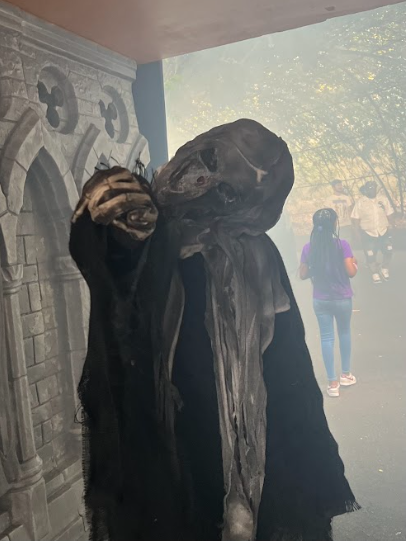***
We want your opinion! Please submit this form.
Just click the link below and answer the questions listed.
***
Background Information
Imagine feeling harsh, violent pains. Whether in your head, stomach, or even chest, what is the first thing you would think to do? Most likely, you would inform a parent or trusted adult. But not in 1692. At this time, most people would blame harmful pains on witches. Most often, witches were described as women, though men witches were not unheard of, and would ‘communicate with the devil’ in an attempt to bring harm to others.
The Salem Witch Trials resulted in the deaths of around 25 people and the imprisonment of over 100 more. According to the University of New Hampshire, “200 people were accused of practicing witchcraft. Twenty were put to death; 15 women and five men; 19 by hanging, and one man was pressed to death…”Most people were accused of witchcraft because of a negative outcome of a scenario. For example, if your harvest for the year was insufficient, people would blame others for their misfortune, calling them a witch.
Those who survived the torment and torture of the witch trials were emotionally scarred for the rest of their life. In today’s time, therapists are a common resource to help with emotional struggles. However, in times like 1692, if you had troubles, you often had nobody to turn to. Sometimes, people who survived would be accused of witchcraft again due to mental health issues. If someone saw you uncontrollably twitching, there was thought to be no other explanation than one: you must be a witch. Many were brought back to be tested again, and those who were not accused again suffered a miserable life of discrimination.
Societal Effect
Fear; that is what would control many minds if witch trials were still a possibility. Waking up, wondering if you seem normal enough to still be called human. Of course, no one is actually a witch, but that doesn’t stop the town. Children would walk playfully, saying “witch, witch!” not knowing that they just sentenced their friend to a fate worse than death. This would be our lives.

Many wonder how heartless a person would have to be to send an enemy, or worse, a friend, to the trials. But the truth is, it’s not about your heart; it’s about your will to live. As the witch trials continued past their original ending date, they would become a larger tradition. People wouldn’t see it as a responsibility to help emphasize their religion; they would see it as a civic duty. The government would use the trials as a way to prove its power to the ever-growing American population. Accusations would become more frequent as both men and women are taken prisoner into the relentless cycle of torment that the witch trials bring.
Hysteria took over the Massachusetts Bay Colony in 1692. To regain control of the colony and eliminate any unsightly breakdowns, the witch trials emerged. However, they caused more harm than good, resulting in England threatening to take away the charter of the Massachusetts Bay Colony. Historical records indicate that by ending the witch trials, Massachusetts was able to restore its government. “‘Salem’s was a short outbreak. It was less than a year between the accusations and the deaths,” says an expert on the Salem Witch Trials, Peone, in an interview with The University of New Hampshire. However, in rewriting history in this article, Massachusetts would never get that charter back.
The government, now weaker than ever, no longer has the right to govern itself. England, too afraid to lose a colony full of possibilities and money, would now have complete control. Instead of a place of new beginnings and ideas, Massachusetts would become a second England. Strict rules and regulations would also come into play. Anyone who breaks the smallest of laws could be convicted of treason. The witch trials wouldn’t be an awful religious practice, but instead propaganda to convince its citizens that anyone who goes against their rules is not aligned with God.

Soon, what was once the beginning of America would be an authoritarian regime. English soldiers would line the streets searching for anyone out of line. Those who commit crimes such as stealing an apple could be seen as a witch, resulting in the punishment of being sent to the trials. Propaganda would line the streets, convincing their citizens to follow what they say. Young children would be taught, as they grow up, to report “witches” to keep their friends and family safe. Rebellions and protests would certainly occur; however, due to the large number of English soldiers controlling the colony, the colonists wouldn’t have a chance.
As England would continue to invest soldiers in the colonies to keep peace, the witch trials would spread. Afraid that history would repeat itself in the many flourishing colonies, the king would take away their charters. Hoping to ensure that the money from the colonies keeps coming, the king would be willing to station soldiers in the other colonies as well. Even those who tried to escape England wouldn’t be safe from this takeover.
Fast forward to today, America as we know it would be gone. Never departing from the English, America wouldn’t have any of the rights we pride ourselves on today. Instead of a place for freedom, we would become a place for England to reap the rewards of our wealthy businesses. Our labor would become their income. At first, protests would be common, but as it becomes clear that we can’t escape the world we were thrown into, they would die down. Fear would keep us silent. All of this was done by inciting fear with witch trials. There wouldn’t be only 24 dead; there would be thousands more.
Haunting Facts
- The majority of people who accused others of witchcraft were young girls. The first people to ever accuse others of witchcraft were Elizabeth Parris (9) and Abigail Williams (11).
- A man named Giles Corey was pressed to death by rocks after neither pleading guilty nor innocent after being accused.
- The youngest person accused of witchcraft was four-year-old Dorothy Good. She was accused of witchcraft after she allegedly bit, pinched, and nearly choked another person. Dorothy was then questioned, where she revealed that she saw her mother conversing with the devil. Dorothy’s mother, Sarah Good, was then arrested and imprisoned. While imprisoned, Sarah Good gave birth to Mercy Good. Two weeks after giving birth, Sarah Good was hanged. After almost eight months in jail, Dorothy Good’s father, William Good, bailed her out.
The Different Witch Tests:
- Prayer Test- If the accused made a mistake while reciting the Lord’s Prayer from memory, then they were a witch.
- Swimming Test – Water symbolizes purity and innocence, so the accused would have their hands and legs bound, and they would be thrown into the water. If they floated, they were a witch (because water is believed to repel evil), and if they sank, they were innocent (but most drowned).
- Weight Test- Witches were supposed to be very light so they would be weighed against the bible, and if they were heavier than the bible, they were innocent. An average bible weighs 2 pounds. Everybody was heavier, but instead of being deemed innocent, they were just given a harder test.
- Touch Test- The accused would have to touch their victim, and if the victim felt pain, the witch was guilty. They had no other proof other than the victim’s word.
- The Cake Test- The accused were forced to bake a cake with their victim’s urine, and they would have to feed the cake to a dog. If the dog became ill after eating the cake, then the accused was a witch.
- Skin Test- If the accused had a birthmark, a mole, or a freckle that did not bleed when pricked, the accused was a witch. Moles do not have blood vessels, so when they are pricked, they do not bleed.










An admirer of JMS from Palm City • Oct 6, 2025 at 12:30 pm
The Salem Witch Trials are a significant part of Massachusetts’ history. My wife’s family members are fifth generation residents of Salem. They were born and raised in the dark history of the Witch Trials. Each year hundreds of thousands of people visit Salem to immerse themselves in witch folklore.
I enjoyed reading this article. It reminded me that religious and mythologic beliefs were strong components of the early settlers’ belief system.
adviser • Oct 6, 2025 at 12:48 pm
What an amazing connection you have to this story! Thanks for sharing!